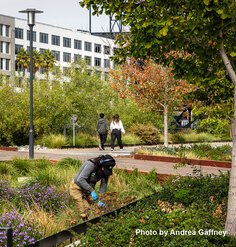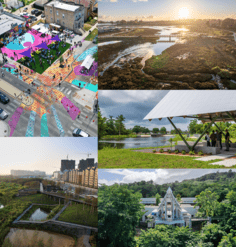A Pulse Check on Landscape Performance in Professional Practice
After celebrating 10 years of the Landscape Performance Series in 2020, LAF continues to promote and invest in landscape performance in order to foster long-term change within the discipline of landscape architecture and beyond. Landscape performance focuses on the measurable environmental, social, and economic impacts of landscape solutions and the use of performance data for improved designs, ongoing management and maintenance, and to make the case for sustainable designs and policies. Although forms of landscape performance research and evaluation have existed for decades, LAF has worked to cement the status of landscape performance as a key aspect of landscape architectural research, education, and practice.
While much progress has been made, perhaps the most challenging aspect has been integrating landscape performance within the everyday, project-by-project practice of professional landscape architecture. Although emerging forms of practice are attempting to change this, professional practice is still largely client- and market-driven with narrow margins. This presents challenges for a performance-focused design process as well as post-occupancy evaluation, which require a scope and timing of services that don’t align with the conventional design process.
To better understand the current state of landscape performance in leading firms, LAF convened eight landscape architecture practitioners who are leaders in landscape performance. Their conversations provided a wealth of perspective and insight into the ways in which landscape performance has become integral to professional practice and where challenges still exist.
Why is landscape performance important to practice?
The practitioners expressed that landscape performance had many different facets. They reported being most invested in landscape performance as a way to improve their own practice and contribute to a larger body of knowledge for the discipline. They considered it helpful, but less essential, for client education or advocacy purposes – expressing that for the most part, they are hired by clients who already believe in their ability to deliver on project goals; or that clients were not interested specifically in performance metrics or evaluation. They also use landscape performance to convey the value of landscape solutions as a way to educate those outside the discipline and market their work.
The practitioners expressed that while comprehensive, the term “landscape performance” can sometimes be too vague – especially when speaking to clients. They suggested that practitioners use alternative terms where appropriate such as “landscape statistics” (when focusing on measurement) or “landscape impact” (when focusing on the delivery of results).
How is landscape performance integrated?
The conversations revealed that this group of practitioners had integrated landscape performance in their work primarily on a project-specific, partnership-based, or opportunistic basis. The most common way was through participating in LAF’s Case Study Investigation (CSI) program to conduct a post-occupancy evaluation of a project. In general, partnering with university faculty or other experts like project consultants was a primary way that those within the group engaged with landscape performance. Some integrated a performance-focused approach in their design process as part of pursuing SITES certification, as driven by individual intellectual curiosity, or as part of site commissioning — a somewhat rare but emerging adaption of the building commissioning process, which is fairly standard for building systems.
What are the barriers?
The most ubiquitous barriers described by the group were: lack of time and funding within project budgets, limited client interest, lack of integration with the tools typically used within design offices, designer discomfort with metrics, and difficulty creating systems to apply lessons learned from previous projects to future projects, even when post-occupancy evaluation is done. Participants felt that a landscape performance approach for all their projects is not feasible or even desirable, and they observed that clients who are long-term land stewards were better suited to a landscape performance-focused approach as compared to the developers who sell or turn over a property to return profit on their investment in the short-term. Some practitioners felt that some projects are more about design and art than a bottom-line, benefits-driven approach. Generally, the group felt that it may be most appropriate to focus on project- or topic-specific landscape performance studies that yield transferrable knowledge to be applied to practice, rather than trying to study all projects.
How can it be scaled?
The practitioners strongly felt that to be effective, landscape performance must be used not only by larger or medium-size firms that work in the public realm but also by smaller firms and residential designers, who collectively influence large areas of land. To reach their full potential, high-performance landscape interventions must be implemented on a broad scale.
Ultimately, integrating landscape performance into design work – whether it’s designing for high-performance landscapes, using performance estimates to pursue certification, conducting post-occupancy evaluation of projects to learn for future designs, or using metrics to convey value – was clearly shown not to be a one-size-fits-all approach.
The reflections of this small group of practitioners demonstrate how far the integration of landscape performance has come. Thank you to our participants:
- Anya Domlesky, Director of Research, SWA
- Allison Harvey, Principal, OJB
- Eric Kramer, Principal, Reed Hilderbrand
- Allyson Mendenhall, Director of Strategic Initiatives, Sasaki
- Meg Plumb, DW Legacy Design Director, Design Workshop
- Rebecca Popowsky, Associate, OLIN Labs
- Stephanie Roa, Senior Designer, LandDesign
- Meghan Talarowski, Executive Director, Studio Ludo
We know that many other practitioners and firms are working to consider landscape performance more comprehensively during the design process and better understand and provide environmental, social, and economic outcomes for their clients and communities. LAF looks forward to continuing to support these efforts through the Landscape Performance Series and Case Study Investigation program.










